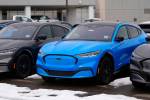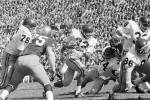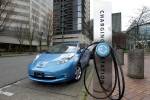Edsel was shunned for its unattractive design
There's an oft-told adage: If you haven't failed at something, you haven't tried hard enough to succeed at anything. A perfect case in point is the Edsel, a car -- a whole line of cars, actually -- that epitomizes failure on a particularly grand scale.
After two brief years in production and untold millions of dollars spent on engineering, tooling and marketing, the misunderstood Edsel flamed out in spectacular fashion. The public actually seemed to enjoy the spectacle of watching Ford tripping over its corporate shoelaces. The Edsel became an international joke with a punchline that reverberates to this day.
Named for Henry Ford's son (who died in 1943), the Edsel should have been a magnificent success. After all, it was conceived at a time when the North American automobile industry was operating at full capacity, churning out cars and trucks in record numbers. With only upstart Volkswagen plus a few other pipsqueak importers to worry about, it was full speed ahead and clear sailing for Detroit.
Fifty years ago, developing another product line to satisfy the incessant demand for more cars was a natural thing to do. In Ford's executive suite, the decision was made to create a midpriced car positioned between its rank-and-file models and its expensive Lincolns. The Edsel line was to be comparable in price to Mercury, but be a bit more daring and flamboyant to attract similar buyers. With a host of standard and available accessories, including powerful V-8 engines, the Edsel was also designed to make the Ford Motor Co. buckets of money.
The leaks to the press as well as the teaser ads appearing in the media hinted that something different from Ford would appear in the fall of 1957, but few observers were ready for what would be unveiled. From the back and sides, the new 1958 Edsel was genuinely appealing. The grille, however, was another matter. Stuck between the front fenders was a monstrous chromed appendage that would become a source of humor for years. It really wasn't all that bad considering the age-of-excess 1950s. In fact, some competing vehicles looked much more garish.
The media saw it differently, though, and thwacked their audience's funny bones with derisive comments about the Edsel's "horse-collar" grille that appeared like "an Oldsmobile sucking a lemon." Other comments about the snout were even less flattering.
Still, the Edsel charged forward. In its initial year, a whopping 18 models bore the name of Henry Ford's male heir, including the Citation, Corsair, Pacer and Ranger coupes, sedans and hardtops and Bermuda, Villager and Roundup wagons. Citations and Corsairs were muscled with 345-horsepower 410 cubic-inch V-8s, while 303-horse 361-cube engines powered Pacer and Ranger models.
Among the more unique items initially integrated into the design was a Teletouch Drive automatic transmission with control buttons located inside the steering-wheel hub. There was also a rotating-drum speedometer that spun like an aircraft directional compass and changed color the faster you drove.
Ford had predicted 100,000 Edsel sales in the first year, but the final 63,100 tally fell short of the mark. Pundits and prognosticators, both of the professional and armchair variety, let loose with we-told-you-so remarks. The Edsel was also becoming a staple of stand-up comedians everywhere.
The company bravely tried to regroup for the 1959 model year, with fewer models that shared a common 120-inch wheelbase ('58 versions had used 116-, 118- and 124-inch lengths) and were fitted with smaller V-8s as well as a base 145-horsepower inline six-cylinder. By year end, sales had plummeted to less than 45,000 and the division's death watch had already begun.
Only a tiny number -- less than 3,000 -- 1960 vehicles sporting more conventional grilles (some would say they looked like Pontiac grilles), quietly rolled off the assembly lines before Ford, to the complete surprise of absolutely no one, ended Edsel production in late 1959.
The ultimate blame for the Edsel debacle is one that has been, and will continue to be, debated for years. Its ultimate and very predictable fate lead to some interesting change at the very top of the Ford empire (the men who ultimately approved the Edsel for production) as well as the dismissal of Ford's advertising agency. It caused much doubt to be cast as to the accuracy and effectiveness of consumer-based surveying methods and focus groups (both still popular today) and it led to much bitterness and bruised feelings at the dealership level. Then there was the Edsel name, an awkward and unglamorous handle chosen from among 6,000 submissions, that failed to click with car shoppers.
Finally, Ford's launch of its new baby couldn't have come at a worse time. The brief but biting recession of 1958 hurt Edsel and nearly every other nameplate. Given the conditions of the time, rookie-season sales of the Edsel weren't that terrible.
The Edsel really had a chance, and a good one, of becoming a success. What really stopped it cold in its tracks was that unusual piece of shiny nosework artistry that bore the brunt, literally as well as figuratively, of all that was wrong with the car.
Ultimately, it sealed the Edsel's fate for good.
Malcolm Gunn is Wheelbase Communications' chief road tester and historic writer. Wheelbase is a worldwide supplier of automobile news, reviews and features.






















